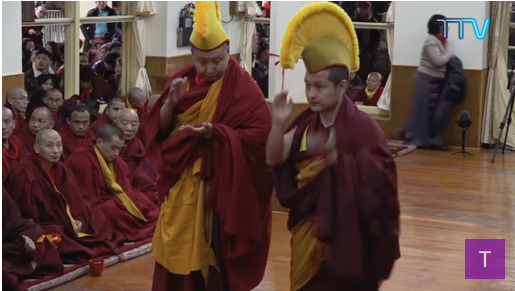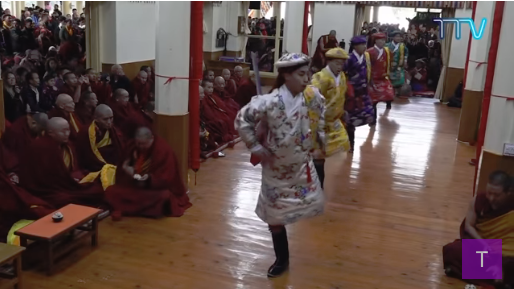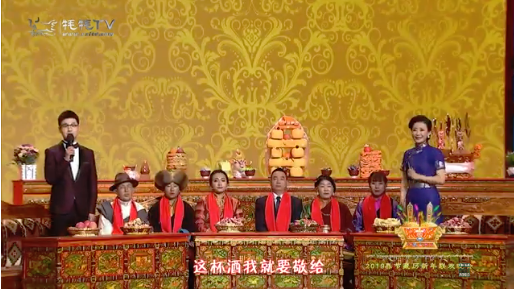
Two monks doing a dialectic debate at the Losar ceremony at the main temple in Dharamsala on the first day.
However, this is not the only time that Losar is celebrated. Although by the name of it, the first day of Losar ought to be the first day of the first month of a new year, historically there have been variations in when people celebrate. These variations are also accompanied by locally originated reasoning. Let me try to explain this historical development here.
How did Losar originate? It has its roots in the pre-Buddhist Bon period. This can be visible from some of the Losar paraphernalia that are supposed to be there on the altar. Items like་“Sheep’s head” (improvisation from the time when there were sacrificial offerings) as well as the use of the image with Swastika and the sun and the moon.
It is said that in Tibet, tradition of celebrating Losar started around 1st century BC during the time of King Pude Gunggyal. It was based on lunar cycle with Losar observed when flowers started blooming on the trees on the sacred Yarlha Shampo Mountain in Lhoka. The current tradition of Losar seems to have been instituted during the time of the Sakya rule over Tibet in the 14th century.

Gar performance is an integral part of the traditional Losar ceremony, as is seen here in Dharamsala on the first day.
Be that as it may, the earliest among the Losar celebrations every year takes place in Kongpo in Tibet, where people observe it on the 1st of the 10th month. It is generally known as Kongpo Losar. According to local legend, in the 13th century, the ruler of Kongpo (Akyi Gyalpo) had to wage a war against the invading Mongol army. While he could not avoid going into battle, at the same time he understood that his soldiers needed to celebrate Losar. Thus, he ordered that it be celebrated before their expedition, and thus the tradition of Kongpo Losar on the 1st of the 10th month was born.
In Ladakh (as well as neighboring Ngari in Tibet) Losar is observed on the first of the 11th month. According to Ladakhi tradition, in the 17th century, similar to the Kongpo version, then ruler of Ladakh, Jamyang Namgyal, had to wage a war against the neighboring Balti ruler. However, since the timing was close to Losar, he resolved the problem of his soldiers being able to go to war and at the same time celebrating Losar by observing the same on the first of the 11th month. In some parts of Tibet, the nomadic community celebrates this day as the Bheu Losar “Calf’s New Year” to celebrate the annual tradition of going to a warmer site where the calves of their cattle are born and returning from a barter trip to nearby settled towns.
The tradition of celebrating Losar on the first of the 12th month is somewhat widespread in the Himalayan region. It is called Sonam Losar (Farmer’s New Year), a tradition that traces its origin to farmers’ doing a celebration after their harvest. In the Tsang region in Tibet, it is also called Tsang Losar.
In Bhutan, too, this day is celebrated as Chunyipai Losar, Losar of the 12th month. According to the Central Monastic Body, the origin of this tradition is traced to the time of Shabdrung Ngawang Namgyal and it marked the occasion when people from all over came to make their annual offerings.
In the Nyarong area of Tibet, there is a tradition of celebrating what could be Losar on the 13th of the 12th month. The people call this the Nyarong Chusum, Nyarong 13th. Similar to the stories from Ladakh and Kongpo, one of the legends in Nyarong say that the observation was moved forward to the 13th because of the ruler’s need to go on a military expedition.
Losar festivities traditionally go on for several days, but the first three days have specific rituals in traditional Tibet. The first day is called Lama Losar as on that day, there are spiritual rituals early in the morning and people go to offer greetings to the Lamas. The second day is known as Gyalpo (ruler, king) Losar as on that day there is the official ceremony where the government officials make traditional offerings to His Holiness the Dalai Lama. This ceremony also includes a display of dialectic dexterity by learned monks and the performance of a song and dance ritual known as Gar by a specially trained troupe. The monks chosen for the dialectic display are selected from the best of the scholars of the monasteries and it is seen as a coveted prize to be won. Interestingly, the King of Ladakh who sent a team of Gar artists to pay respect to the 5th Dalai Lama introduced it to Tibet in the 17th century. Impressed by the performance, the Dalai Lama issued a decree to establish a Tibetan troupe specializing in Gar song and dance. Thus was born the tradition of performing Gar during such official ceremony. The third day is called Tensung Losar when the state oracles come into trance, protecting deities are propitiated, and prayer flags are hoisted.
Now a word about the designation of the year. This year is the Female Earth-Pig year. As you can see, it is composed of three categories: gender, element and the zodiac animal. An element (iron, water, wood, fire and earth) is paired with a gender for two consecutive years along with a Zodiac animal (Mouse, Ox, Tiger, Rabbit, Dragon, Snake, Horse, Sheep, Monkey, Bird, Dog, and Pig). Thus, since this is a Female Earth Pig Year, next year will be Male Iron Mouse Year and the year after that Female Iron Ox. The whole circle is completed in a 60-year cycle, which is called a Rabjung. We are currently in the 17th Rabjung period.

Two anchors along with a group of Tibetans who were among several such Tibetans shown showering praises on President Xi Jinping and the Communist Party at the Losar gala on TV in Lhasa.
In the post-1959 period, the Tibetan people have had to change the nature of the Losar celebrations. In Tibet, after the Chinese takeover, community Losar celebration, which is connected to Tibetan religious and cultural tradition, had to change because of the nature of the Chinese Communist ideology. In fact, these days the main community event in Tibet is the evening Losar gala concert on TV rather than the official spiritual ceremony before Chinese rule. The concert by Tibet TV in Lhasa this year, in itself a mixture of Tibetan and Chinese items, was particularly political with many Tibetans brought to mouth praise to Xi Jinping and the Communist Party at regular intervals. In addition, popular Tibetan artists are performing skits in Chinese rather than in Tibetan, making them artificial. In contrast, the one from Qinghai TV in Amdo, was comparatively wholesome and was a proud display of Tibetan cultural tradition. I am yet to see the Losar program on the TV in Kham at the time of writing this blog.
In exile, His Holiness the Dalai Lama and the Tibetan people’s life in a different society meant that certain changes were inevitable. Losar celebrations currently is a condensed version of what used to happen in Tibet. It does include the pre-dawn prayers, the Gar performance, and the dialectics display. In the United States, as also in the West in general, the Tibetan community had to adapt further. Families do try to visit nearby monastery or Buddhist center on the first day, the community Losar celebrations often tend to be scheduled to a weekend as some people even have to report for work on the first day of Losar. Nevertheless, they do include some spiritual and traditional components.
Happy Losar to everyone, whether or not you are celebrating it!

